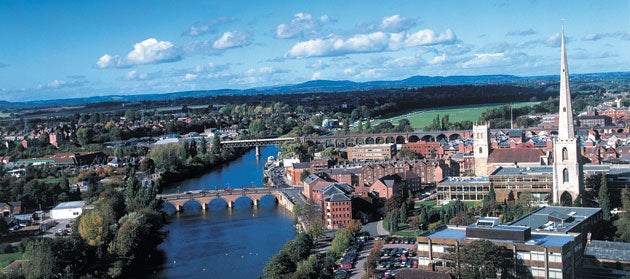Universities: Worcester's source of pride
One very new university is pulling in applicants at a phenomenal rate. Lucy Hodges investigates

Worcester is famous for being the site of Charles II's decisive battle. It boasts a medieval cathedral and is bisected by the River Severn, which floods occasionally to dramatic effect. But most people have no idea that it has had a university since 2005, let alone a university that is becoming phenomenally popular among students.
Last week's Ucas figures show that applications to the University of Worcester have doubled in the past five years. It has so far logged 8,438 applications for entry this autumn, which is a 98.9 per cent increase on 2003, the biggest by far of any university in Britain and one that Professor David Green, the vice chancellor, attributes to Worcester's courses as well as the care it takes over how students are doing.
The students, who have been chosen to talk to me, don't hesitate to echo his words. "This university has a very good support network," says Kate Webberley, 33, who is training to be a paramedic. Victoria Taylor, 22, who is on a teacher training course after a first degree at Nottingham University, agrees. "The university appealed to me because it was a teacher training college," she says. "Everyone is very friendly."
Worcester gives undergraduates a lot of flexibility and choice. If they take a degree in business studies, for example, they can also study public relations and advertising. If they study journalism, they can combine it with English language. "This combination of traditional subjects with newer ones has led to a massive increase in applications," says John Ryan, the university's registrar.
"We have brought together some of the creative arts, so we have digital media, animation and illustration alongside traditional drama and performance."
The morphing of the institution from an emergency teacher training college in the Second World War to today's university has been slow and not without setbacks. Along the way, it became an institute of higher education and a university college. In 2002 Sir Howard Newby, the former chief executive of the Higher Education Funding Council (Hefce), suggested that Worcester should expand big-time and build another campus, but at that stage Hefce was not funding extra student numbers, so the ambition came to nought.
Amazingly, the local burghers turned down the idea of Worcester becoming a university in the 1960s, and, although there is more enthusiasm for higher education in the city today, there is concern about the effect that large numbers of students can have on housing, noise levels and the street scene.
That anxiety is being met by the university's decision to expand beyond its present site across the River Severn to create a second campus in a run-down city centre spot, almost on top of the railway and bus stations. Students will, therefore, be spread out around what is a small city, rather than being concentrated in one area.
The new campus will be built in and around the old Worcester Royal Infirmary. "It was going to be sold for housing," says Green. "We managed to get it."
This expansion should be the making of the university, enabling it to grow beyond its 8,100 student population to 12,000. It should also help to bring higher education to the residents of Herefordshire and Worcestershire, who have not had the chances of people in other parts of Britain.
"It will make the university much more visible to all sections of the town," says Green. "That city centre location will have quite a profound effect over the course of the next decade."
It may not improve the university's position in the league tables (in The Independent's Complete University Guide this year Worcester came 93rd out of 113), but it should cement its standing in the region, bringing new jobs and life to the city. On the new site will be a science and technology centre to encourage local children to take up those subjects. "We have designed the campus to welcome schoolchildren to give them the idea that the university could be for them," says Green.
There will also be learning galleries containing art and design, a public square for outdoor performances, a business centre and a wellbeing centre.
One of the pride and joys of the development is Britain's first joint university/public library, a merger of the city library and the university's children's library in the teacher education faculty. It has attracted large sums of money – £55m in total – from central government, the regional development agency and Hefce.
At the same time, the university became one of Hefce's strategic development funded projects. This enabled it to bid for extra student numbers, just as Cumbria University and the Combined Universities in Cornwall have done, and the rest is history. Howard Newby's ambition for Worcester is being fulfilled.
From wartime college to leafy campus – lowdown on a young contender
History: Began life as an emergency teacher training college in the Second World War, became an institute of higher education, a university college, and finally a university in 2005.
Ambience: Leafy campus hidden away in the St John's district. New £120m city centre campus about to go up on the other side of the River Severn, concentrating on creative arts and business, and producing, it is hoped, a new cultural quarter for the city.
Students: Of 8,100 students, more than 50 per cent are part-time, two-thirds mature, almost three-quarters women.
Glittering alumni: Jacqui Smith, the Home Secretary; Jo Yapp, the England ladies rugby captain.
Who's the boss? Professor David Green, economist.
Subscribe to Independent Premium to bookmark this article
Want to bookmark your favourite articles and stories to read or reference later? Start your Independent Premium subscription today.

Join our commenting forum
Join thought-provoking conversations, follow other Independent readers and see their replies